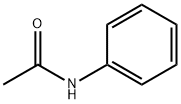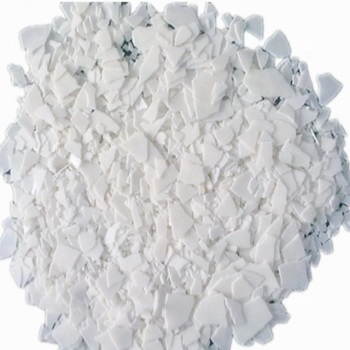
АЦЕТАНИЛИД
- английское имяAcetanilide
- CAS №103-84-4
- CBNumberCB9444812
- ФормулаC8H9NO
- мольный вес135.16
- EINECS203-150-7
- номер MDLMFCD00008674
- файл Mol103-84-4.mol
химическое свойство
| Температура плавления | 113-115 °C(lit.) |
| Температура кипения | 304 °C(lit.) |
| плотность | 1,121 g/cm3 |
| плотность пара | 4.65 (vs air) |
| давление пара | 1 mm Hg ( 114 °C) |
| показатель преломления | 1.5700 (estimate) |
| Fp | 173 °C |
| температура хранения | Store below +30°C. |
| растворимость | Slightly soluble in water; very soluble in ethanol and acetone; soluble in ethyl ether. |
| форма | Powder |
| пка | 0.5(at 25℃) |
| цвет | Off-white to beige to grayish-blue |
| РН | 5-7 (10g/l, H2O, 25℃) |
| Растворимость в воде | 5 g/L (25 ºC) |
| Мерк | 14,50 |
| БРН | 606468 |
| Диэлектрическая постоянная | 2.9(22.0℃) |
| Стабильность | Stable. Combustible. Incompatible with strong oxidizing agents, caustics, alkalies. |
| LogP | 1.160 |
| Справочник по базе данных CAS | 103-84-4(CAS DataBase Reference) |
| Рейтинг продуктов питания EWG | 1 |
| FDA UNII | SP86R356CC |
| Справочник по химии NIST | Acetamide, N-phenyl-(103-84-4) |
| Система регистрации веществ EPA | Acetanilide (103-84-4) |
больше
| Коды опасности | Xn | |||||||||
| Заявления о рисках | 22-36/37/38 | |||||||||
| Заявления о безопасности | 22-26-36 | |||||||||
| WGK Германия | 1 | |||||||||
| RTECS | AD7350000 | |||||||||
| Температура самовоспламенения | 540 °C | |||||||||
| TSCA | Yes | |||||||||
| кода HS | 29242995 | |||||||||
| Банк данных об опасных веществах | 103-84-4(Hazardous Substances Data) | |||||||||
| Токсичность | LD50 intragastric in rats: 800 mg/kg (Smith, Hambourger) | |||||||||
| NFPA 704: |
|
рисовальное письмо(GHS)
-
рисовальное письмо(GHS)

-
сигнальный язык
предупреждение
-
вредная бумага
H302:Вредно при проглатывании.
-
оператор предупредительных мер
P301+P312+P330:ПРИ ПРОГЛАТЫВАНИИ: Обратиться за медицинской помощью при плохом самочувствии. Прополоскать рот.
АЦЕТАНИЛИД химические свойства, назначение, производство
Химические свойства
Acetanilide, also known as Nphenylacetamide, acetanil, or acetanilide is a white to gray solid with molecular formula CH3CONHC6H5. It is an odorless colorless, glossy, crystalline powder or flakes. Acetanilide was the first aniline derivative found to possess analgesic as well as antipyretic properties and was quickly introduced into medical practice (Weast, 1981; Gnanasambandan et al., 2014). Later, it was established that in the human body it is mostly metabolized to paracetamol, this compound being responsible for the analgesic and antipyretic properties of acetanilide (Bertolini et al., 2006; Gnanasambandan et al., 2014). In addition, it was discovered that it has unacceptable toxic effects, so that acetanilide is no longer used as a drug.
Acetanilide is mainly used as an intermediates in the synthesis of pharmaceuticals and dyes, as an additive for hydrogen peroxide and cellulose ester varnishes, and as a plasticizer in polymer industry as well as accelerator in the rubber industry.
Физические свойства
White glossy flake crystal or white crystalline powder. Slightly soluble in cold water, soluble in hot water, methanol, ethanol, ether, chloroform, acetone, glycerol and benzene.История
The department of internal medicine at the University of Strassburg in the 1880s was noted for its investigations into intestinal worms. Adolf Kussmaul, the director, asked two young assistants, Arnold Cahn and Paul Hepp, to treat patients with naphthalene as it had been used elsewhere as an internal antiseptic. The young doctors were disappointed with the initial results, but Hepp persevered with the naphthalene treatment in a patient suffering from a variety of complaints besides worms. Surprisingly, the fever chart revealed a pronounced antipyretic effect from this treatment. This had not been observed before, but further investigation revealed that Hepp had wrongly been supplied by Kopp’s Pharmacy in Strassburg with acetanilide instead of naphthalene! Cahn and Hepp lost no time in publishing a report on their discovery of a new antipyretic.For many years after its discovery in 1886, Acetanilide was used as an alternative to aspirin (i.e. acetyl salicylate) - an analgesic (painkiller) and antipyretic (fever reducing) drug to relieve e.g. headache, menstrual pain, and rheumatic pain. Under the name “Acetanilide” it formerly appeared in the formula of a number of patent medicines and over the counter drugs. In 1948, Julius Axelrod and Bernard Brodie discovered that Acetanilide is much more toxic in these applications than other drugs, causing methemoglobinemia and ultimately causing damage to the liver and kidneys. Thus, Acetanilide has largely been replaced by less toxic drugs, in particular acetaminophen (i.e. paracetamol), which is a metabolite of Acetanilide and whose use Axelrod and Brodie suggested in the same study.
прикладной
Acetanilide is used as an inhibitor of hydrogen peroxide decomposition and to stabilize cellulose ester varnishes. It is also used in the intermediation of rubber accelerator synthesis, dyes and dye intermediate synthesis, and camphor synthesis. Acetanilide is used for the production of 4-acetamidobenzenesulfonyl chloride, a key intermediate for the manufacture of the sulfa drugs. It is also a precursor in the synthesis of penicillin and other pharmaceuticals. In the 19th century acetanilide was one of a large number of compounds used as experimental photographic developers.Acetanilide is used as a EOF (electroosmotic flow) marker in the studies of affinity capillary electrophoresis for drug–protein binding.
Acetanilide undergoes palladium-catalyzed cross-coupling reaction to form ortho-acylacetanilide.
Подготовка
Acetanilide is prepared from aniline by acetylating it with acetic anhydride in presence of glacial acetic acid. Aniline reacts with acetic anhydride to form Acetanilide by nucleophilic substitution reaction and the reaction is called acetylation.
In a 100 ml round bottom flask fitted with a reflux condensor place 5ml of aniline and 10 ml of 1:1 acetic acid and acetic anhydride mixture (5ml acetic acid and 5 ml acetic anhydride). Heat the mixture gently under reflux for 15-20 minutes on oil bath and then pour the contents while still hot with stirring into a 200ml beaker containing 100ml ice cold water. Stir the mixture vigorously to hydrolyse the excess acetic anhydride. After all the acetanilide has precipitated, collct it on buchner funnel and wash with cold water. Recrystallise the crude product from boiling water. If the product is excessively coloured add a pinch of animal charcoal to hot water and filter hot through glass wool/ cotton plug. Pure colourless crystals of acetanilide melts at 114°C (5-5.5g).
Определение
ChEBI: Acetanilide is a member of the class of acetamides that is acetamide in which one of the hydrogens attached to the nitrogen is substituted by a phenyl group. It has a role as an analgesic. It is a member of acetamides and an anilide. It is functionally related to an acetic acid.Всемирная организация здравоохранения(ВОЗ)
Acetanilide, a para-aminophenol derivative with analgesic, antipyretic and weak antiinflammatory activity, was introduced into medicine in 1886. It subsequently proved to be excessively myelosuppressive and has been superseded by safer alternatives.Общее описание
Acetanilide is a white to gray solid. (NTP, 1992)Реакции воздуха и воды
Acetanilide is sensitive to prolonged exposure to air . Water insoluble.Профиль реактивности
Acetanilide is an amide. Flammable gases are formed by the reaction of organic amides with strong reducing agents. Amides are very weak bases (weaker than water). Imides are less basic yet and in fact react with strong bases to form salts. That is, they can react as acids. Mixing amides with dehydrating agents such as P2O5 or SOCl2 generates the corresponding nitrile. The combustion of these compounds generates mixed oxides of nitrogen (NOx).Пожароопасность
Acetanilide is combustible.Профиль безопасности
A human poison by an unspecified route. Poison by ingestion and intravenous routes. Moderately toxic by intraperitoneal route. Human systemic effects by ingestion: hallucinations and dstorted perceptions, sleepiness, constipation, cyanosis, respiratory stimulation, hdney damage, me themoglobinemiacarboxyhemoglobinemia, and decreased body temperature. Mutation data reported. When heated to decomposition it emits toxic fumes of NOx,. Combustible when exposed to heat or flame. See also ANILINE.Возможный контакт
This amide compound is used in rubber industry as accelerator, in plastics industry as cellulose ester stabilizer, in pharmaceutical manufacture, stabilizer for hydrogen peroxide, azo dye manufactureПеревозки
UN2811 Toxic solids, organic, n.o.s., Hazard Class: 6.1; Labels: 6.1-Poisonous materials, Technical Name Required.Методы очистки
Recrystallise acetanilide from water, aqueous EtOH, *benzene or toluene. [Beilstein 12 IV 373.]Несовместимости
Dust may form explosive mixture with air. Incompatible with oxidizers (chlorates, nitrates, peroxides, permanganates, perchlorates, chlorine, bromine, fluorine, etc.); contact may cause fires or explosions. Keep away from alkaline materials, strong bases, strong acids, oxoacids, epoxides, alkyl nitrates, alkalis (liberate aniline), chloral hydrate, phenols, ferric saltsУтилизация отходов
Add to flammable solvents (alcohol or benzene) and incinerate. Oxides of nitrogenmay be scrubbed from combustion gases with alkaline solutionАЦЕТАНИЛИД запасные части и сырье
АЦЕТАНИЛИД поставщик
| поставщик | телефон | страна | номенклатура продукции | благоприятные условия |
|---|---|---|---|---|
| +86 13288715578 +8613288715578 |
China | 12449 | 58 | |
| +86-13131129325 | China | 5867 | 58 | |
| +86-021-62885108 +8613917661608 |
China | 2068 | 57 | |
| +86-0371-55170693 +86-19937530512 |
China | 21667 | 55 | |
| +86-0551-65418679 +8618949832763 |
China | 2989 | 55 | |
| +86-0371-86658258 +8613203830695 |
China | 29889 | 58 | |
| +86 18953170293 | China | 2931 | 58 | |
| 18871490254 | CHINA | 28180 | 58 | |
| +86-531-88989536 +86-15508631887 |
China | 2966 | 58 | |
| +86-19930503282 | China | 8821 | 58 |